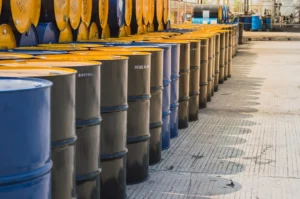(Evaluation) The worldwide oil market faces a stern problem. Brent crude, the world’s pricing commonplace, has fallen 8% to $64.50 per barrel as of April 4, 2025, its lowest in 4 years, whereas America’s West Texas Intermediate (WTI) stands at $61.50.
This decline, steeper since Brent’s $71.04 and WTI’s $68.26 on March 4, stems from China’s tariffs on U.S. items and OPEC+’s deliberate output enhance.
Can oil-producing nations and corporations, together with Brazil’s stalwart Petrobras, climate this storm with out compromising stability?
A Historic Measure: Context Over Panic
Brent at $64.50 is a retreat from 2024’s $80 common and 2022’s $95 excessive, whereas WTI’s $61.50 dips beneath its $77.58 mark in 2023.
These ranges recall early 2021, not the chaos of 2020—when WTI briefly turned detrimental and Brent sank to $19.33—or the $35 lows of 2016, which examined even Petrobras’ presalt ventures.


Inflation-adjusted, $64.50 harks again to 2003’s modest vary, a far cry from Brent’s $93 peak final 12 months. This isn’t a collapse however a correction, pushed by oversupply and commerce tensions with China, a reminder of markets’ cyclical nature.
The Trigger: Commerce Missteps and Provide Selections
China’s retaliatory 34% tariff on U.S. imports, efficient April 10, amplified fears of a world commerce warfare stifling oil demand.
This commerce friction clouds demand, a priority for Petrobras, which depends on Asian markets. In the meantime, OPEC+’s choice so as to add 138,000 barrels per day this month, earlier than anticipated, has tilted the supply-demand stability.
Goldman Sachs warns of dangers to its $78 Brent outlook for 2025, however observers know markets usually self-correct. Nonetheless, the strain is actual, testing resolve throughout the oil patch.
A Check of Power: Who Stands Agency?
Oil’s viability hinges on breakeven costs—budgets for nations, operations for firms. At $64.50 Brent and $61.50 WTI, the divide is evident, with Petrobras proving a mannequin of endurance.
Excessive-Threat Nations: Fiscal Fragility
Iran ($195 fiscal breakeven): Sanctions and low costs pressure Tehran’s funds, the place oil funds 40% of spending. Instability may observe, a geopolitical danger conservatives monitor carefully.
Nigeria ($144): With 90% of exports from oil, $64.50 jeopardizes order within the Niger Delta, a priority for international safety.
Algeria ($125.70): Hydrocarbons prop up 60% of its income; skinny reserves sign hassle forward.
Iraq ($93.80) and Saudi Arabia ($96.20): Iraq’s modest reserves and Saudi’s $900 billion fund provide buffers, however $64.50 challenges Iraq’s rebuilding and Saudi’s diversification.
These nations face robust selections—cuts or deficits—but conservatives worth resilience over rash response.
Low-Threat Nations: Steadfast Producers
Russia ($42-$58): Low prices and Asian exports hold Moscow sturdy, a practical survivor regardless of Western strain.
Qatar ($55) and UAE ($64): Environment friendly and rich, they handle $64.50, with UAE simply breaking even operationally ($30-$40).
Norway ($35-$45): A $1.5 trillion fund and low-cost fields guarantee stability, a mannequin of fiscal prudence.
Brazil ($43-$60): Petrobras’ presalt fields, at $43-$50 breakeven, anchor Brazil’s place, proving state-led corporations can thrive in lean instances.
These international locations, led by corporations like Petrobras, uphold the conservative preferrred of self-reliance.
Firms: Self-discipline Pays Off
Excessive-Threat: U.S. shale’s smaller gamers ($62-$70 for brand spanking new wells) falter at $61.50 WTI, a blow to American power jobs. Canada’s oil sands ($57-$75) wrestle, their prices uncovered.
Low-Threat: Saudi Aramco ($20-$30) and ADNOC ($30-$40) lead with effectivity. ExxonMobil and Chevron ($40-$55) endure through scale, Rosneft ($33-$50) through Russia’s grit, and Petrobras ($43-$50) through presalt prowess—a testomony to strategic focus.
The Outlook: Challenges and Alternatives
Excessive-risk nations—Iran, Nigeria, Algeria—face pressure, however conservatives see this as a market purge of the weak.
A drop to $60, as Citi suggests inside a 12 months, may take a look at even Saudi Arabia and Iraq, although Petrobras’ resilience gives Brazil leverage.
Low-risk gamers—Russia, Qatar, Petrobras—stand to achieve, maybe consolidating energy as others retreat.
For the U.S., $61.50 WTI slows shale, a priority for power independence, but cheaper gasoline aligns with conservative priorities of household budgets over authorities fixes.
China’s commerce warfare squeezes Petrobras’ Asian gross sales, however low costs may soften its financial hit. Petrobras, pumping 3.5 million barrels each day (2023), stays a linchpin for Brazil’s stability.
A Severe Second? Sure, However Not Deadly
Brent at $64.50 and WTI at $61.50 sign a critical take a look at, not a loss of life knell. Excessive-risk producers really feel the pinch, however spare capability and dangers—Iran’s defiance, Houthi threats—could cap the slide.
Petrobras and its friends show disciplined producers endure. The market will type itself, because it at all times has, rewarding those that stand agency.